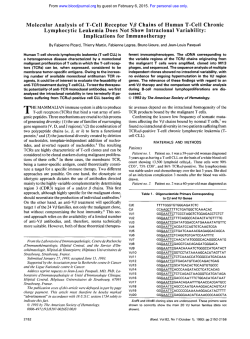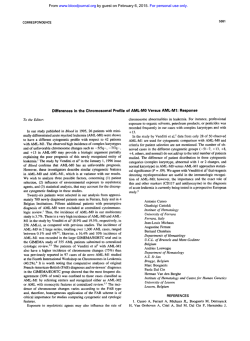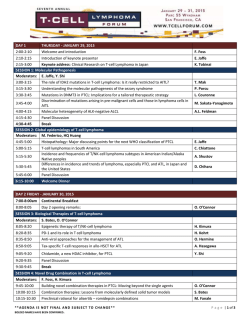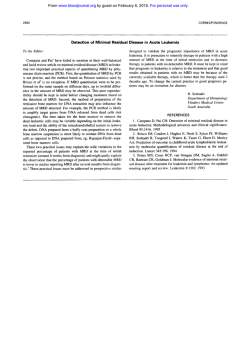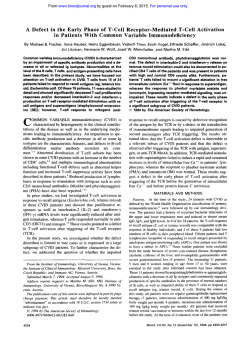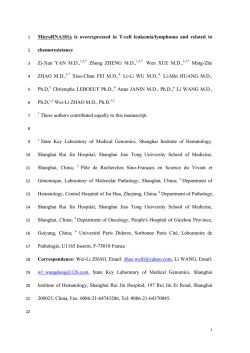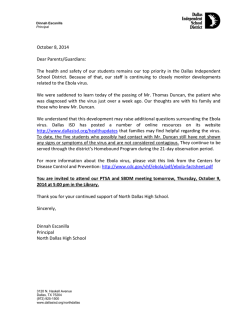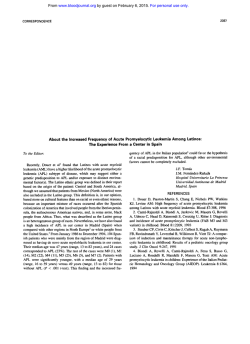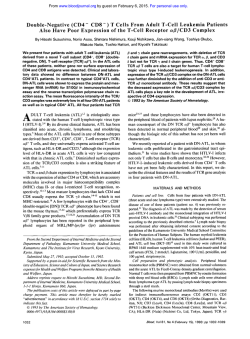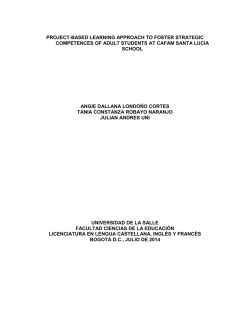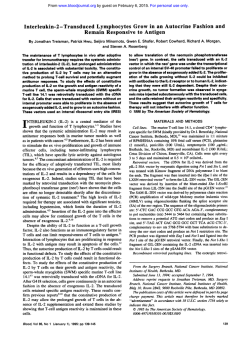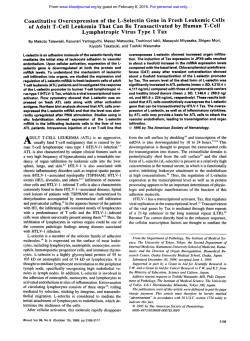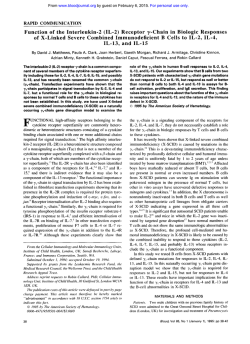
Characterization of T Cells Immortalized by Taxl of Human T
From www.bloodjournal.org by guest on February 6, 2015. For personal use only. Characterization of T Cells Immortalized by Taxl of Human T-cell Leukemia Virus Type 1 By Tsuyoshi Akagi, Hiroaki Ono, and Kunitada Shimotohno Peripheral blood T cells were immortalized in vitro by introduction of the Taxl gene of human T-cell leukemia virus type 1 (HTLV-1)with a retroviral vector and were characterized for transformation-associated markers. Long-term observation showed that these Taxl-immortalized T cells eventually exhibitedvery similar features that were characteristic of HTLV-1-immortalized T cells, ie, increased expressionof egr-l, c-fos, IL-ZRa, and Lyn and decreased expression of Lck and cell-surface CD3 antigen. Among thesechanges, an increase in tho expression of Lyn and a decrease in the expression of Lck and cell-surface CD3 antigen were observed H UMAN T-CELL leukemia virus type 1 (HTLV-l) is etiologically associated with adult T-cell leukemia (ATL) and tropical spastic paraparesis (TSP)/HTLV-1-associated myelopathy (HAM).’.’ This virus characteristically has the ability to immortalize normal T cells invitro.’,’ HTLV-l-immortalized T cells differ inmany ways from normal T cells. The interleukin-2 (IL-2) requirement for cell growth is decreased inmany HTLV-1-immortalized T cell^.^,^ HTLV-1-immortalized T cells show altered cellsurface phenotypes; eg, expression of CD25 (L-2Ra) and major histocompatibility complex (MHC) class I1 antigen is constitutively augmented, whereas expression of the CD31 T-cell receptor (TCR) complex d e c r e a s e ~ . ~T”cells ~ immortalized by HTLV-1 constitutively express many kinds of immediate early serum responsive genes.”.‘’ Furthermore, many HTLV-1 -immortalized T cells show changed expression patterns of src-family tyrosine kinases. HTLV-1-immortalized T cells, especially IL-2-independent cells, frequently express a decreased level of Lck, a major tyrosine kinase in normal T cells.I3 In contrast, many HTLV-1-immortalized T-cell lines show high-level expression of Lyn that is barely detectable in normal T cells.I4 Tax l , a transcriptional trans-activator of this virus, interacts with at least three distinct cellular transcriptional factors: cyclic AMP-responsive element-binding proteidactivating transcription factor (CREB/ATF), nuclear factor KB(NFKB), and serum responsive factor (SRF).I5 Through the interactions of these transcriptional factors, Taxl transcriptionally activates not only its own long terminal repeat (LTR), but also some immediate early serum-responsive genes (c-fos, c-jun, egr-l, etc), cytokine genes (IL-2, IL-3,GM-CSF, TGF01, etc), and its receptor gene (IL-2Ra).’*I5 This activation of cellular genes is thought to leadto T-cell transformation.l2l5We and others have shown that primary human T cells can be immortalized by the introduction of the Taxl In our previous study, we characterized the growth properties of Tal-immortalized T cells at early passage (several months after the introduction of Taxl) and reported that these T cells showed a greatly increased proliferative response to stimulation with anti-CD3 antibody, mainly through an L-2-independent pathway.16 In this study, we have investigated the Taxl-immortalized T cells for a long period (up to 3 years) and found that these T cells eventually showed very similar phenotypes to those of T cells immortalized by HTLV-1. Many of the characteristic features of HTLV-l -immortalized T cells appear to be attributable to the function of Tax 1. Blood, Vol86, No 1 1 (December l), 1995:pp 4243-4249 only in Taxl-immortalized T cells after long-term culture. The expression level of Taxl protein did not differ significantly between early andlate passage of cells, and the cellular clonalitywas found to bethe same by the analysis ofthe retroviral vector integration site and the T-cell receptor pchaingenerearrangement pattern. Thesechanges in the expression of Lyn, Lck, and cell-surface CD3 antigen probably resultedfrom indirect effectsof Taxl that appeared after extended culture. 0 1995 by The American Society of Hematology. MATERIALS AND METHODS Cells and cell culture. Primary human T cells derived from the peripheral blood of a healthy donor were infected with a taxl-expressing retroviral vector, DGL-Taxl, or a control vector, DGL, followed by selection with G418. Detailed experimental procedures for establishment of these retroviral vector-infected cells were described previously.’8 These infectants were maintained inAIM-V medium (GIBCO, Grand Island, NY) supplemented with 10% fetal calf serum (FCS), 10 ng/mL recombinant IL-2 (Takeda, Osaka, Japan), and 0.05 mmol/L 2-mercaptoethanol. Frozen stocks of these cells from various culturing periods were used in this study. KN6HT is an HTLV-1-infected human CD4+ helper T-cell clone,” and FU-KOS-3 is an HTLV-l-uninfected normal human CD4+ helper T-cell clone derived from the peripheral blood of a healthy donor.’” These cells were also maintained in the same medium as described above. Southern blot analysis. Genomic DNA (10 pp) was digested with restriction endonucleases, separated by electrophoresis in 0.8% agarose, and blotted onto a nitrocellulose membrane. The membrane was hybridized with3’P-labeled Taxl-specific probe (a 1.3-kb BamHI-Sal I fragment from pUC/Taxl), as described previously.’* The membranes were then washed in 0.2X SSC and 0.1% sodium dodecyl sulfate (SDS) at 65°C for 1 hour and exposed to x-ray films with intensifying screens at -70°C. Northern blot analysis. Total cellular RNA (10 pg) was electrophoresed in 1.O% agarose containing formaldehyde and MOPS and blotted onto a nitrocellulose membrane. The membrane was hybridized with ’*P-labeled probe, as described previously,18washed with 0.2X SSC and 0.1% SDS at 65°C for 1 hour, and exposed to x-ray film with intensifying screens at -70°C. The DNA fragments used as probes were as follows: human c-fos cDNA, a 2.1-kb EcoRI fragment of pSFT-fos cDNA’’; human egr-l cDNA, nucleotides 2530 to 3109 of ETR103”; human IL-2 cDNA, a 0.6-kb Pst I- Fromthe Virology Division, National Cancer Center Research Institute, Tsukiji, Chuo-ku, Tokyo, Japan. Submitted April IO, 1995; accepted August I , 1995. Supported in part by Grants-in-Aid for Cancer Research and Grants-in-Aid for a Comprehensive IO-Year Strategy for Cancer Control from the Ministry of Health and Welfare of Japan. Address reprint requests to Kunitada Shimotohno, PhD, Virology Division, National Cancer Center Research Institute, 5-I - I Tsukiji, Chuo-ku, Tokyo 104, Japan. The publication costs of this article were defrayed in part by page charge payment. This article must therefore be hereby marked “advertisement” in accordance with 18 U.S.C. section 1734 solely to indicate this fact. 0 1995 by The American Society of Hematology. 0006-4971/95/8611-0033$3.00/0 4243 From www.bloodjournal.org by guest on February 6, 2015. For personal use only. AKAGI, ONO, AND SHIMOTOHNO 4244 D m I fragment of p3-16”; human IL-2Ra cDNA, a 1.3-kb Hind111 fragment of pKCR. Tac-2.AZ4; human Lck cDNA. a I .8-kb NCO IHind111 fragment of YT16”; and human Lw cDNA, nucleotides 264 to 1949 of PLY-30.’‘ TheseDNAfragmentswerelabeledwith a multiprimeDNAlabelingsystem(Amersham,AmershamPlace, m,, UK). I F/Nnrescence-activoted cell sorter (FACS)ona/wis. Fluorescein isothiocyanate (F1TC)-conjugated monoclonalantibodiesagainst CD2 (LeuS), CD3 (Leu4). CD4 (Leu3a). CD5 (Leul), CD25 (IL2R1). CD28 (KOLT-2). CD4SRA (2H4). and CD4SRO (UCHLI) to were used to detect the cell-surface marker. Cells were allowed react with optimal concentrations of these antibodies and were analyzed with flow cytometer, Cytoron-Absolute (Ortho, Raritan, NJ). T-cell proliferorinn ussa~. T-cellproliferationwasassayed by measuring the incorporation of ’H-thymidine. T cells were cultured in AIM-V medium containing 10% FCS either in the absence or in the presence of IL-2 ( I 0 ng/mL) in flat-bottom 96-well plates (4 X IO4 cellsper well). After 48 hours,each well was pulsed for 18 hourswith I pCi ’H-thymidine. The cellswereharvestedand the radioactivity of the 5% trichloro acetic acid-insoluble fraction was measured in a liquid scintillation counter. Results are presented a s the means of triplicates f. SD. Imrnunohlotfing lmmunoblottingwasperformedessentially as described.”’ Briefly, S X IO5 cells were pelleted and lysed in 100 pL of 2X SDS-polyacrylamide pel electrophoresis (SDS-PAGE) sample buffer. After quantitating the protein by BCA protein assay reagent (Pierce, Rockford, IL), each lysate corresponding to S p g of protein was fractionated on 10% SDS-PAGE. and the proteins were electrophoreticallytransferred to Immobilon(Millipore,Bedford,MA). After blocking with 3% bovine serum albumin in TBS (10 mmol/L Tris-HCI, pH 7.4, 140 mmol/L NaCI) overnight at room temperature. themembraneswereincubated with mouseanti-Taxmonoclonal antibody TAXY7” in the blocking buffer forI hour. The membranes were then washed extensively with TBS containing0.1% Tween 20, incubated for I hour at room temperature with horseradish peroxidase-conjugated sheep antimouse IgG antibody, washed, and developed with theAmershamECLchemiluminescencereagentasdirected by the manufacturer. RESULTS Immortalization of Taxl-transduced peripheralblood lymphocytes (PBLs). Continuously growing cells canbe obtained from PBLs after infection with the Tax I -expressing retroviral vector, DGL-Tax1 . Two cell lines designated PBL/ DGL-Tax 1 A and PBLIDGL-Tax 1 B were established from two independent infection experiments. Expression of Tax 1 in these cells was confirmed as described previously.’” PBL/ DGL-Tax 1A and PBLIDGL-Tax1 B have continued to grow in IL-2-containing medium for nearly 4 and 2 years. respectively. Such long-term proliferating cells were not obtainable from the PBLs that were infected with a control vector DGL. AlthoughPBLIDGL could proliferate for several months after infection in IL-2-containing culture medium, its rate of proliferation gradually declined thereafter andfinally ceased to grow. Early passage of PBWDGL-Tax I A did not differ from PBWDGL in its morphology. but, after culturing over 2 years, a morphologic change in the phenotype of PBLIDGL-Tax 1 A could be observed. These cells increased in size and formed large, irregular aggregates. Analysis of the clonalie. We maintainedtheDGLTax1 -infected PBLs as a bulk population without cell cloning after infection. We later determined the clonal composition of these cells by analyzing the integration sites of the 5s PBUDGL-TaxlA d E C L *I I I d d 3 4 E Pa m 1 2 21 kb- 5 kb4 kb5 Fig 1. Southern blot analysis of the retroviral vector integration site. Each DNA was digested with BamHI, which cut once within the retroviral vector, DGL-Taxl, and was subjected to Southern blot analysis with Taxl-specific probe. Lane1, PBL/DGL-TaxlA at3 months PI; lane 2, PBL/DGL-TaxlA at 6 months PI; lane 3, PBL/DGLTaxlA at24 months PI; lane 4, PBL/DGL-TaxlA at 36 months PI; lane 5, PBL/DGL-TaxlB at 22 months PI. retroviral vector by Southern blottingwith Taxl-specific probe. PBLIDGL-TaxIA at 3. 6, 24. and 36 months postinfection (PI) and PBUDGL-TaxIB at 22 months PIwere examined (Fig l ) . In PBL/DGL-TaxIA, one major and one minorband were detected at 3 months PI (lane I ) . At 6 months PI (lane 2), only the major band was seen. and this pattern did not change thereafter (lanes 3 and 4). Thus. PBU DGL-Tax 1 A consisted of a mixed population of at least two clones at 3 months after infection that became monoclonal at 6 months and remained so up to at least 36 months. PBL/ DGL-TaxIB was monoclonal at 22 months PI (lane S ) . The integration pattern of the retroviral vector differed between PBLIDGL-Tax 1 A and PBLIDGL-Tax I B; therefore. these two were different clones. The same resultwas obtained from an analysis for clonality by Southern blottingwith a probe for the TCR &chain gene (data not shown). Cell-surfcrce phenotyprs. Cell-surface expression of CD3. CD4, CD25 (IL-2Ra). and CD28 antigens in PBL/ DGL-TaxIA and PBUDGL-Tax I B was analyzed byflow cytometry. PBL/DGL at 6 months PI was also examined as a control. As shown in Fig 2. PBLIDGL. PBLIDGL-TaxIA (except for 36 months PI), and PBUDGL-Tax 1 B all had the phenotype of helper T cells, CD3’ and CD4’. In contrast. PBLIDGL-TaxIA at 36 months PI showed a markedly decreased level of CD3 expression and a slight reduction in CD4 expression. Expression of CD25 (IL-2Ra) was higher in all the DGL-Tax 1 infectants than in PBWDGL, especially in long-term cultured DGL-Tax I infectants (PBLIDGLTaxlA at 24 months PIand 36 months PI and PBL/DGLTax I B at 22 months PI). Percentages of CD28’ cells were 70% to 80% in PRLlDGL at 6 months PI and in PBL/DGLTax I A at 6 and 24 months PI and were 90% t o 95% in PBL/ From www.bloodjournal.org by guest on February 6, 2015. For personal use only. Tax1 IMMORTALIZED T CELLS 4245 CD3 CD28 C D4 96 PBUDGL 6m P.I. 64 32 32 - 6 64 128 192 256 64192 128 256 256 64 128 192 256 64192 128 256 PBU DGL-Tax1 A 6m P.I. 24m P.I. 64 32 36m P.I. 32 PBU D G L - T a lB 64 "1 64 128 192 258 64 128 64 192 g61 64 64 l Fig 2. Analysis of cell-surface phenotypes. Cells cultured in IL-2-containing medium were subjected to FACS analysis. Cytofluorometric profiles of cells stained with anti-CD3 antibody, anti-CD4 antibody, anti-CD25 antibody, or anti-CD28 antibody are shown. The names of the cells examined are indicated on the left. The vertical axis indicates relative cell numbers. The horizontal axis indicates relative fluorescence intensities. We confirmed that the fluorescence intensity of the staining with negative control antibody, FITC-conjugated normal mouse IgG, was less than 64 in each case. DGL-Tax1 A at 36 months PI and PBL/DGL-Tax 1 B at 22 months PT. As for other cell-surface markers, we found that all of these Tax I -immortalized T cells are CD2' , CD5 ' , and CD45RO' (data not shown). IL-2 dependrwcy on cell proliferution. Growth properties of PBL/DGL-Tax IA and PBWDGL-TaxlBwithor without IL-2 were analyzed. KN6-HT,an HTLV- I -immortalized human CD4' helper T-cell clone, and a PBL/DGL culture at 6 months PT were also examined as controls. As shown in Fig 3, all of these cells could proliferate in the presence of 1L-2. In the absence of IL-2, significant levels of proliferation were observed in PBUDGL-Tax I A of late passages (24 and 36 months PI) and in PBL/DGL-Tax1B at 22 months PI, but these levels were much lower than that of KN6-HT. However, theseTax1-immortalized T cells could not be maintained for more than 1 month after completedepletion of TL-2, whereas KN6-HT could (data not shown). Therefore, Tax1-immortalized T cells retained their IL-2 dependency even at 36 months PI. Analysis of cellular gene expression. We further characterized the Tax 1 -immortalized T cells by using Northern blot analysis to examine the expression of several cellular genes (Fig 4A). Initially, we focused on genes of e g r - l , c-fos, IL, are known to betrans-activated by 2, and I L - ~ R c Ywhich Tax I . Compared with PBL/DGL, all of the DGL-Tax1 infectants expressed egr-l and c:fo.r at a much higher level. From www.bloodjournal.org by guest on February 6, 2015. For personal use only. AKAGI, ONO, AND SHIMOTOHNO 4246 - id 12 ’- 4 - T IL-2 ( ) Fig 3. Analysis of IL-2 dependency on cell proliferation. Cell proliferationinthe absence I-) or the presence (+) of IL-2 was measured by 3H-thymidine incorporation assay. The names of the cells examined are indicated below. Columns and bars show means and standard deviations, respectively, for triplicate samples. That level was almost the same or even higher than that of an HTLV-l-infected T-cell clone, KN6-HT. None of the cells expressed IL-2 mRNA.The expressionlevel of ZL2Ra was slightly higher in PBL/DGL-TaxlA from an early passage (6 months PI) and much higher in later passages of PBL/DGL-Tax I A (24 and 36 months PI) andin PBLIDGLTaxlB at 22 months PI. The expression level of these genes in those long-term cultured cells was almost the same as that of KN6-HT. We then analyzed the expression of src-family tyrosine kinases, Lek and Lyn (Fig 4A), because altered production of these kinases in HTLV-I -infected T cells is r e p ~ r t e d . ’ ” ’ ~ Lek, which is knowntobethemajortyrosinekinase in in PBLIDGL and most of normal T cells,”~26 was expressed the DGL-Tax 1 infectants, except for PBL/DGL-Tax1 A at 36 months PI. Expression of Lck was markedly decreased in KN6-HT and PBWDGL-Tax1 A at 36 months PT. We could hardly detect Lck mRNA in PBUDGL-TaxlA at 36 of the gene was evident months PI, whereas slight expression in KN6-HT. On the qther hand,increased expression of Lyn, which is known to be expressed ata very low level in normal T ~ e l l s , ’ was ~ ~ *observed ~ in KN6-HT and in the long-term cultured DGL-Tax 1 infectants, PBLDGL-Tax1 A at 24 and 36 months PI, and PBL/DGL-TaxlB at 22 months PI. We confirmed that the expression levels of Lck and Lyn in a normal helper T-cell clone, FU-KOS-3,’” were quite similar to those of PBUDGL and markedly different from those of PBL/DGL-Tax I A at 36 months PI (Fig 4B). Analysis of Tux1 expression. Therewas a clear difference in theexpression of genes for Lek and Lyn between the early and latepassages of DGL-Tax1 infectants, as indicated; therefore, weexaminedthepossiblerole of Taxl in the altered expression of these genes. There were no significant differences in the amount of Tax1 protein in these DGLTaxl infectants (Fig 5). Thus, the difference in the cellular gene expression could not be explainedby the level of Taxl protein. DISCUSSION Primary human T cells derived from PBLs wereimmortalized by transduction of Tux1 using a retroviral vector. Al- though we maintained the Tax1 -transduced PBLs as bulk populations in IL-2-containing medium, the immortalized cells weremonoclonal CD4’ T cells at 6 months PI. We estimated the infection efficiency to be around 0.1% (data not shown); therefore, clonal selection of the infected cells should have occurred. Such clonal selection is reported for the course of T-cell immortalization by HTLV-1 .27.28 Two Taxl-immortalized T-cell clones were established from two independent infection experiments. These two clones showeddifferentintegration patterns of retroviralvector. Therefore, it is less likelythat the immortalization was caused by the insertional activation of some cellular oncogene by the retroviral vector at the integration site. Grassmannet all7 also reportimmortalizationofprimary human T cells by Taxl. They used Herpesvirus Suirniri vector, which retained most of the large viral genome, including the recently identified genes for cyclin-like protein and Gprotein-like protein.*””’ In contrast, the retroviral vector used in this work encodes only Taxl and neoI8 and seems to be preferable for evaluating the effect of Tax 1. T cells immortalized by HTLV-l are known to have several characteristic features that are distinct from normal T cells. In thisstudy, we showed that TaxI-immortalized T cells eventually exhibited features that were very similar to those characteristic features of T cellsimmortalized by HTLV- l , ie, increased expression of egr-I, c7fos, IL-2Ra, and Lyn and decreased expression of Lek and cell-surface CD3 antigen. In addition, we previouslyreportedthatthe Tax 1 -immortalized T cells resembled HTLV- 1 -immortalized T cells in the aberrant expression of G D 2 g a n g l i o ~ i d e . ~ ~ Investigation of one of theTaxl-immortalizedT-cell clones at various times in culture showed that, among these alterations associated with transformation, an increase in the expression of Lyn and a decrease in the expression of Lck and cell-surface CD3 antigen were observed only in longterm cultured cells. This finding was in marked contrast to theincreased expression of egr-l, c-fos, and IL-2Ra observed both in early and latepassages. However, augmented expression of IL-2Ra was detectedinlate-passagedcells. Because the Tax1 -transduced T cells became monoclonal as early as 6 months P1 and retained their clonality as shown From www.bloodjournal.org by guest on February 6, 2015. For personal use only. Taxl IMMORTALIZED T CELLS 4247 B n egf- l - 3 v) 0 Y 3 LL 3.1kb ..r). 2.2kb 4 l.Okb 4 3.5kb ..- - IL-2Ra 3.8kb LYn 4 1.5kb Lck *2.2kb LYn -3.8kb 1""r 4 ~ rRNA ~ 4 18s rRNA 1 28s 18s 2 3 4 5 6 1 2 3 Fig 4. Northern blot analysis of cellular gene expression. Total RNA was isolated from cells cultured in IL-2-containing medium and subjected t o Northern blot analysis. The names of the probesused are indicated on the left. The sizes of thebands are indicated on the right. Ethidium bromide staining of rRNAs is shown at the bottom. (A) Lane 1, KN6-HT, an HTLV-l-immortalized human CD4' helper T-cell clone; lane 2, PBL/DGL at 6 months PI; lane 3, PBL/DGL-TaxlA at 6 months PI; lane 4, PBL/DGL-TaxlA at 24 months PI; lane 5, PBL/DGL-TaxlA at 36 months PI; lane 6, PBL/DGL-TaxlB at 22 months PI. (B) Lane 1, FU-KOS-3, a normal humanCD4' helper T-cell clone; lane 2, PBL/DGL at 6 months PI; lane 3, PBL/DGL-TaxlA at 36 months PI. by analysis of the retroviral vector integration site and the TCR rearrangement pattern, it is unlikely that a preexisting minor clone with a different phenotype from the major population in the early passage became dominant after long-term culture. Moreover, there was no significant difference in the amount of Taxl protein between the early and late passages of Taxl-transduced T cells. Considering these results, the changes in the expression of Lyn. Lck, and cell-surface CD3 antigen may have been indirect effects of Tax 1 that appeared only after the long culturing period. That the induced expression of Tax1 in JURKAT cells stably transfected with f a r 1 gene does not change the expression levels of Lck and the &chain of CD3 also supports the indirect involvement of Tax1 in the decreased expression of these genes.'I There are many reports describing the progressive changes in the properties of T cells infected with HTLV- 1 ."',33-35 Based on long-term observation, Yssel et alJSreported that, after infection of a T-cell clone with HTLV-I, two distinct phases, phase I and 11, are observed. Phase I cells are seen early after infection, proliferate inan IL-2-dependent way, and are not different from the uninfected parental clone in morphology or cell-surface expression of the CD3iTCR complex. Phase I1 cells, which emerge later, proliferate in the absence of IL-2 in large dense aggregates, have a giant celllike appearance, do not express the CD31TCR complex on their surface, and therefore cannot respondto the signals through the CD3iTCR complex. Although the expression of src-family tyrosine kinases in phase I1 HTLV-I -infected T cells was not investigated in their study. Bolen et al" described that decreased IL-2 dependency in HTLV-I-infected T cells correlates with decreased amounts of Lck and significant increases in the expression of Lyn. Based on those results, altered expression of src-family tyrosine kinases is expected to occur in phase 11 HTLV-I-infected T cells. PBLDGL-Tax1 A showed very similar phenotypic changes during extended time in cultures, as described here. More- From www.bloodjournal.org by guest on February 6, 2015. For personal use only. AKAGI,ONO, 4248 PBU DGL-Tax1A l 1 2 3 4 5 6 Fig 5. lmmunoblot analysis of Taxl protein. Whole cell lysate was prepared from cells cultured in IL-2-containing medium. Each lysate correspondingto 5 p g of protein was subjected to immunoblot analysis with mouse anti-Tax monoclonal antibody TAXY7. The band for p40TnX' is indicated by an arrow. Lane 1, KN6-HT, an HTLV-l-immortalized human CD4' helper T-cell clone; lane 2, PBLlDGL at 6 months PI; lane 3, PBL/DGL-TaxlA at 6 months PI; lane 4, PBL/DGL-TaxlA at 24 months PI; lane 5, PBL/DGL-TaxlA at 36 months PI; lane 6, PEL/ DGL-TaxlB at 22 months PI. over, as reported previously," whereas Taxl-transduced T cells at early passage (corresponding to PBL/DGL-TaxIA at 6 months PI in this study) showed hyper-responsiveness to stimulation through the CD31TCR complex, PBL/DGLTaxlA at 36 months PI did not respond (data not shown). In this way, PBUDGL-Tax1A at 36 months PI resembled phase I1 HTLV- I -infected T cells in many aspects. In PBL/ DGL-TaxIB cultured for 22 months, expression of Lyn increased notably and Lck expression decreased slightly, but cell-surface expression of CD3 antigen did not decrease significantly. This phenotype is very similar to that of PBL/ DGL-Tax I A at 24 months PI, and we expect that PBL/DGLTaxlB will exhibit the same phenotypic changes as PBL/ DGL-TaxIA after more prolonged culture. Considering the close similarities between PBL/DGL-Tax1 A at 36 months PI and many HTLV-I-immortalized T cell^,'^^"^" Tax1 itself seems to play a crucial role in the expression of many characteristic features of HTLV-I -immortalized T cells. The molecular mechanisms underlying the progressive changes observed in TaxI-immortalized T cells are not clear. Tax1 is reported to repress the expression of the DNA pol p gene that is involved in DNA repair and thereby induces DNA damage.'".37 Accumulation of DNA damage during long culturing periods may lead to these phenotypic changes. But, considering the particular phenotype that appeared in many HTLV-I -immortalized T cells as well as in Tax 1 -immortalized T cells, involvement of epigenetic change of cellular gene expression, such as progressive changes with cellular aging, rather than the accumulation of random mutations seems more likely. In this context, it is noteworthy that several transcriptional factors that are known to be regulated by Taxl, such as AP-I, ATFEREB, and SRF, have been reported to alter its activities with cellular aging.3x-4'There is a possibility that, with cellular aging, the function of Tax1 as a transcriptional trans-activator for many cellular genes AND SHIMOTOHNO is modulated by these changes in cellular transcriptional factors. Despite the similarities to phase I1 HTLV-l -infected T cells, long-term cultured TaxI-immortalized T cells remained IL-2 dependent evenat 36 months PI. Grassmann et all' also reported the IL-2 dependency of the T cells immortalized by a Tax 1 -expressing Herpesvirus Scrimin' vector. These results imply that, in addition to toxl. other viral genes, such as env gene and a recentlyidentifiedp12' gene"')..'' may be required to establish a fully IL-2-independent growth state. In this report, we clearly showed the importance of Tax1 in many aspects of phenotypic transformation by HTLV-I. Further investigation of our Tax I -immortalized T cells will help to unravel the precise molecular mechanisms leading to the transformation of T cells after HTLV-I infection. ACKNOWLEDGMENT We thank Dr Y. Yamanashi (University of Tokyo, Tokyo, Japan), Dr T. Hirano (University of Hiroshima, Hiroshima, Japan), and Dr Y. Koga (University of Kyushu. Kyushu, Japan) for providing probe DNAs. We also thank Dr Y. Tanaka (University of Kitasato. Tokyo, Japan) and Dr M. Yasukawa (University of Ehime, Ehirne. Japan) fur supplying anribody and the T-cell clone, respectively. REFERENCES 1. FeuerG,Chen IS: Mechanismsof human T-cell leukemia virus-inducedleukemogenesis.Biochimica Biophysica Acta I 114: 223. 1992 2. Hollsberg P, HaRer DA: Seminars in medicine of the Beth Israel Hospital. Boston. Pathogenesis of diseases induced by human lymphotropic virus type I infection. N Engl J Med 328:l 173, 1993 3. Hoshino H, Esumi H, Miwa M. Shimoyama M. Minato K, Tobinai K, Hirose M, Watanabe S. Inada N. Kinoshita K. Kamihira S, lchimaru M. Sugimura T Establishment and characterization of 10 cell lines derived from patients with adult T-cell leukemia. Proc Natl Acad Sci USA 80:606 I . I983 4. Mer1 S, Kloster B, Moore J. Hubbell C, Tornar R, Davey F, Kalinowski D, Planas A, Ehrlich G,Clark D, Comis R. Poiesz B: Efficient transformation of previously activated and dividing T lymphocytes by human T cell leukemia-lymphoma virus. Blood 64:967, I984 S. Hattori T, Uchiyama T. Toibana T. Takatsuki K, Uchino H: Surface phenotype of Japanese adult T-cell leukemia cells characterized by monoclonal antibodies. Blood %:MS.1981 6. Gallo RC, Mann D, Broder S. Ruscetti F W , Maeda M, Kalyanaraman VS, Robert-Guroff M, Reitz MS Jr: Human T-cell leukemia-lymphoma virus (HTLV) is in T but not B lymphocytes from a patient with cutaneous T-cell lymphoma. ProcNatl Acad Sci USA 795680. 1982 7. Mann DL, Popovic M, Murray C, Neuland C, StrongDM, Sarin P, Gallo RC, Blattner WA: Cell surface antigen expression in newborn cord blood lymphocytes infected with HTLV. J lmmunol 131:2021, 1983 8. Yodoi J, Uchiyama T, Maeda M: T-cell growth factor receptor in adult T-cell leukemia. Blood 62509. 1983 M, 9. Sugamura K, Fujii M. Kannagi M, Sakitani M, Takeuchi Hinuma Y: Cell surface phenotypes and expression ofviral antigens of various human cell lines carrying human T-cell leukemia virus. Int J Cancer 34:221, 1984 IO. Tsuda H. Takatsuki K: Specific decrease in T3 antigen density in adult T-cell leukaemia cells: 1. Flow microfluorometric analysis. Br J Cancer 50:843, 1984 From www.bloodjournal.org by guest on February 6, 2015. For personal use only. Tax1 IMMORTALIZED T CELLS 11. Fujii M, Niki T, Mori T, Matsuda T, Matsui M, Nomura N, Seiki M: HTLV-1 Tax induces expression of various immediate early serum responsive genes. Oncogene 6:1023, 1991 12. Kelly K, Davis P, Mitsuya H, Irving S, Wright J, Grassmann R, Fleckenstein B, Wan0 Y, Greene W, Siebenlist U: A high proportion of early response genes are constitutively activated in T cells by HTLV-I. Oncogene 7:1463, 1992 13. Koga Y, Oh-Hori N, Sat0 H, Yamamoto N, Kimura G, Nomot0 K Absence of transcription of Ick (lymphocyte specific protein tyrosine kinase) message in IL-2-independent, HTLV-1-transformed T cell lines. J Immunol 142:4493, 1989 14. Yamanashi Y, Mori S, Yoshida M, Kishimoto T, Inoue K, Yamamoto T, Toyoshima K Selective expression of a protein-tyrosine kinase, p561yn, in hematopoietic cells and association with production of human T-cell lymphotropic virus type I. Proc Natl Acad Sci USA 86:6538, 1989 15. Yoshida M: HTLV-l Tax: Regulation of gene expression and disease. Trends Microbiol 1:131, 1993 16. Akagi T, Shimotohno K Proliferative response of Taxl-transduced primary human T cells to anti-CD3 antibody stimulation by an interleukin-2-independent pathway. J Virol 67:1211, 1993 17. Grassmann R, Berchtold S, Radant I, Alt M, Fleckenstein B, Sodroski JG, Haseltine WA, Ramstedt U: Role of human T-cell leukemia virus type l X region proteins in immortalization of primary human lymphocytes in culture. J Virol 66:4570, 1992 18. Akagi T, Nyunoya H, Shimotohno K: Murine retroviral vectors expressing the taxl gene of human T-cell leukemia virus type 1. Gene 106:255, 1991 19. Inatsuki A, Yasukawa M, Kobayashi Y: Functional alterations of herpes simplex virus-specific CD4+ multifunctional T cell clones following infection with human T lymphotropic virus type I. J Immuno1 143:1327, 1989 20. Akagi T, Ono H, Shimotohno K: Increased protein tyrosinephosphorylation in primary T-cells transduced with taxl of human T-cell leukemia virus type I. FEBS Lett 358:34, 1995 2 1. Miller AD, Curran T, Verma IM: c-fos protein can induce cellular transformation: A novel mechanism of activation of a cellular oncogene. Cell 3651, 1984 22. Shimizu N, Ohta M, Fujiwara C, Sagara J, Mochizuki N, Oda T, Utiyama H: A gene coding for a zinc finger protein is induced during 12-0-tetradecanoylphorbol-13-acetate-stimulated HL-60 cell differentiation. J Biochem 111:272, 1992 23. Taniguchi T, Matsui H, Fujita T, Takaoka C, Kashima N, Yoshimoto R, Hamuro J: Structure and expression of a cloned cDNA for human interleukin-2. Nature 302:305, 1983 24. Nikaido T, Shimizu A, Ishida N, Sabe H, Teshigawara K, Maeda M, Uchiyama T, Yodoi J, Honjo T: Molecular cloning of cDNA encoding human interleukin-2 receptor. Nature 31 1631, 1984 25. Tanaka Y, Yoshida A, Tozawa H, Shida H, Nyunoya H, Shimotohno K: Production of a recombinant human T-cell leukemia virus type-I trans-activator (taxl) antigen and its utilization for generation of monoclonal antibodies against various epitopes on the taxl antigen. Int J Cancer 48:623, 1991 26. Bolen JB, Thompson PA, Eiseman E, Horak ID: Expression and interactions of the Src family of tyrosine protein kinases in T lymphocytes. Adv Cancer Res 57:103, 1991 27. Hahn B, Gallo RC, Franchini G, Popovic M, Aoki T, Salahuddin S Z , Markham PD, Staal F W : Clonal selection of human T-cell leukemia virus-infected cells in vivo andin vitro. Mol Biol Med 2:29, 1984 28. de Rossi A, Aldovini A, Franchini G , M m D, Gallo RC, Wong-Staal F Clonal selection of T lymphocytes infected by cell- 4249 free human T-cell leukemidymphoma virus type I: Parameters of virus integration and expression. Virology 143540, 1985 29. Nicholas J, Cameron KR, Honess RW: Herpesvirus saimiri encodes homologues of G protein-coupled receptors and cyclins. Nature 355:362, 1992 30. Jung JU, Stager M, Desrosiers RC: Virus-encoded cyclin. Mol Cell Biol 14:7235, 1994 31. Furukawa K, Akagi T, Nagata Y,Yamada Y, Shimotohno K, Cheung NK, Shiku H, Furukawa K: GD2 ganglioside on human Tlymphotropic virus type I-infected T cells: Possible activation of beta-l ,4-N-acetylgalactosaminyltransferasegene by p40tax. Proc Natl Acad Sci USA 90:1972, 1993 32. Wan0 Y, Feinberg M, Hosking JB, Bogerd H, Greene WC: Stable expression of the tax gene of type I human T-cell leukemia virus in human T cells activates specific cellular genes involved in growth. Proc Natl Acad Sci USA 85:9733, 1988 33. Mitsuya H, Jarrett W,Cossman J, Cohen OJ, Kao CS, Guo HG, Reitz MS, Broder S: Infection of human T lymphotropic virusI-specific immune T cell clones by human T lymphotropic virus-I. J Clin Invest 78:1302, 1986 34. Yarchoan R, Guo HG, Reitz M Jr, Maluish A, Mitsuya H, Broder S: Alterations in cytotoxic and helper T cell function after infection of T cell clones with human T cell leukemia virus, type I. J Clin Invest 77:1466, 1986 35. Yssel H, de Waal Malefyt R, Duc Dodon MD, Blanchard D, Gazzolo L, de Vries JE, Spits H: Human T cell leukemiaflymphoma virus type I infection of a CD4+ proliferativekytotoxic T cell clone progresses in at least two distinct phases based on changes in function and phenotype of the infected cells. J Immunol 142:2279, 1989 36. Jeang KT, Widen SG, Semmes OJT, Wilson SH: HTLV-l trans-activator protein, tax, is a trans-repressor of the human betapolymerase gene. Science 247: 1082, 1990 37. Majone F, Semmes OJ, Jeang KT: Induction of micronuclei by HTLV-I Tax: A cellular assay for function. Virology 193:456, 1993 38. Atadja PW, Stringer KF, Riabowol KT: Loss of serum response element-binding activity and hyperphosphorylation of serum response factor during cellular aging. Mol Cell Biol 144991, 1994 39. Dimri GP, Campisi J: Altered profile of transcription factorbinding activities in senescent human fibroblasts. Exp Cell Res 212:132, 1994 40. Riabowol K, Schiff J, Gilman MZ: Transcription factor AP1 activity is required for initiation of DNA synthesis and is lost during cellular aging. Proc Natl Acad Sci USA 89:157, 1992 41. Seshadri T, Campisi J: Repression of c-fos transcription and an altered genetic program in senescent human fibroblasts. Science 247:205, 1990 42. Sikora E, Kaminska B, Radziszewska E, Kaczmarek L: Loss of transcription factor AP-1 DNA binding activity during lymphocyte aging in vivo. FEBS Lett 312:179, 1992 43. Ciminale V, Pavlakis GN, Derse D, Cunningham CP, Felber BK: Complex splicing in the human T-cell leukemia virus (HTLV) family of retroviruses: Novel mRNAs and proteins produced by HTLV type I. J Virol 66:1737, 1992 44. Koralnik U, Gessain A, Klotman ME, Lo Monico A, Bememan ZN, Franchini G: Protein isoforms encoded by the pX region ofhuman T-cell leukemidymphotropic virus type I. Proc Natl Acad Sci USA 89:8813, 1992 45. Franchini G, Mulloy JC, Koralnik U, Lo Monico A, Sparkowski JJ, Andresson T, Goldstein DJ, Schlegel R. The human T-cell leukemidymphotropic virus type I p121 protein cooperates with the E5 oncoprotein of bovine papillomavirus in cell transformation and binds the 16-kilodalton subunit of the vacuolar H+ ATPase. J Virol 67:7701, 1993 From www.bloodjournal.org by guest on February 6, 2015. For personal use only. 1995 86: 4243-4249 Characterization of T cells immortalized by Tax1 of human T-cell leukemia virus type 1 T Akagi, H Ono and K Shimotohno Updated information and services can be found at: http://www.bloodjournal.org/content/86/11/4243.full.html Articles on similar topics can be found in the following Blood collections Information about reproducing this article in parts or in its entirety may be found online at: http://www.bloodjournal.org/site/misc/rights.xhtml#repub_requests Information about ordering reprints may be found online at: http://www.bloodjournal.org/site/misc/rights.xhtml#reprints Information about subscriptions and ASH membership may be found online at: http://www.bloodjournal.org/site/subscriptions/index.xhtml Blood (print ISSN 0006-4971, online ISSN 1528-0020), is published weekly by the American Society of Hematology, 2021 L St, NW, Suite 900, Washington DC 20036. Copyright 2011 by The American Society of Hematology; all rights reserved.
© Copyright 2025
